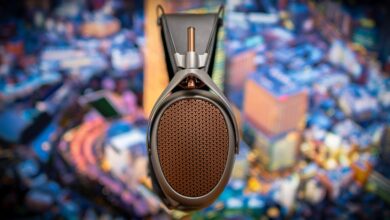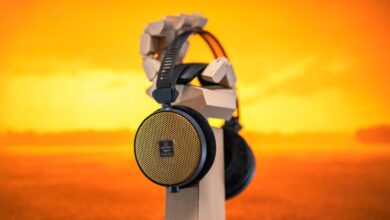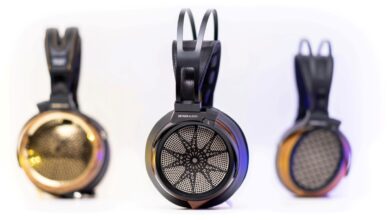World Premiere Sennheiser HD 660S2 Review – The Saga Continues

My Video Review:
Ah…the sound of my youth. How vivid, beautiful, fresh, and seducing you are. I’m not about the beer-tapping sound and partying at ear-bleeding levels, I’m about the Sennheiser house sound being polished for so many years now. My journey as a headphone enthusiast started with a set of Sennheiser HD580 Jubilee which I tried in the early 2000s. I couldn’t afford them back then, but a few years later I was rocking Sennheiser’s Holy Trinity: HD580 Jubilee, HD600, and HD650 which were added later to my collection. Online forums were new concepts back then, but after sweeping HeadWize and Head-Fi (much) later on, I discovered that thousands of people shared their passion with me. If you consider yourself an avid headphone listener, then you owned or at least tried any of these or their alter-egos in the form of HD58X or HD6XX released by Drop.
As of right now Drop sold 250.000 units of HD58X and HD6XX combined in just a few years. Stop for a moment and think about that number as we are talking about two headphones and a single retailer. A lot of people enjoy Sennheiser’s house sound and it would be a mourning day in the history of headphones if they would reshape their tonality or even their looks. Just before Christmas of 2017, Sennheiser put a gift under my tree, which was later revealed to be a brand-new HD660S that refined three decades old lineage, by making them easier to drive, faster & clearer sounding, while leaving their tonality in close vicinity as millions were still enjoying that particular house sound.
Roses weren’t so red and violets weren’t that blue as a few things were left unchecked & dumped under a rug. I got over their limited low-end delivery and bass slam, but I couldn’t get over their lack of dynamics, hence moving to a pair of planar-magnetic headphones later on. I was still bothered by the (in)famous Sennheiser veil that was hiding tiny nuances, I didn’t particularly enjoy their limited cruising speed and I wasn’t the biggest fan of their distortion when going louder. Sennheiser used that constructive feedback as fuel for their internal fire, putting their minds to good use and coming out with a worthy successor, going with a fitting HD660 S2 name. With these, everything feels old and new again and while they look similar, things are more diverse on the inside, but more about that in a flash. These will set you off $599 in the USA, €599 in Europe, and £499 in the UK, and let’s find out if these are worth it or not.

Design & Build Quality
After owning most Sennheiser mid-end headphones, I was surprised that a much smaller package was used this time around. Mother Earth is happier as you won’t find a huge display case anymore, exchanging it with a soft carry pouch which I’ll put to good use. There’s another positive change, as you won’t find 3-meter-long cables of the original HD660S, exchanging them with shorter 1.8-meter cables terminated with 6.35mm and 4.4mm jacks. There is some basic information and if you need a detailed spec sheet and additional info, then there’s a QR code that lets you download everything you need.
Build quality-wise…there’s a striking similarity with HD660S as these look almost identical from afar, but come a little closer and small details will stage dive in front of your eyes. Their cup holders are no longer rounded, spotting a flat surface that shouldn’t damage their coating after putting them on the table hundreds of times. All Sennheiser accents were coated with bronze, giving them a distinct look. After a closer inspection, it seems that the L and R markings were moved on the inside of their yokes, which in turn are slightly thicker at their base, withstanding a higher force once twisted. The Sennheiser logo is smaller and less obtrusive and there are several additional changes. What’s important thought is that these are still designed in Germany and manufactured in Ireland, so you can expect a long service life. Buy yourself an extra pair of earpads and an additional headband padding and you can gift them to your children at a point in your life.
You can still change their worn earpads and headband, you can swap their cables in a flash as these are still serviceable without being tech savvy. All materials remained unchanged sans their driver assembly, leading to similar weight and comfort levels. At 260 grams these are still some of the lightest audiophile-worthy desktop headphones, but the notorious clamping force is still there. You can still bend them to your will and for that gently stretch the headband with bare hands and adjust it to your head size.

Tech Inside Sennheiser HD660S2
This is where things are getting quite exciting and let’s start with the voice coil. After removing the earpads of the original and updated model, you can see a shorter voice coil, meaning that more energy is being transferred from the magnet to the diaphragm. The voice coil was revised to match the HD600 & HD650, so it went back to 300 Ohms, which slightly lowered their sensitivity from 106 dB to 104 dB per a single mW of power. In simpler words, the newest model is less efficient, but it’s considerably more dynamic sounding, especially in the bass.
Secondly, the airflow around the transducer was optimized by decreasing the energy of unwanted sound waves happening between the front and back of the driver. Since there is less vibration and better mechanical decoupling – there is less distortion, resulting in a clearer sound that can be felt across the entire frequency range.
Thirdly, the resonant frequency has been dropped from 110 Hz to 70 Hz, which increased the bass output significantly, more exactly by about ~5 to 6 dB in the lowest octaves.
Their main goal was finding meaningful solutions after receiving years of constructive feedback and then crafting a successor that hopefully would live up to Sennheiser standards. After going back and forth in between the new and old models, it was clear to me that things are going in the right direction and I think this is the right time to hit some eardrums, diving deep into their performance.
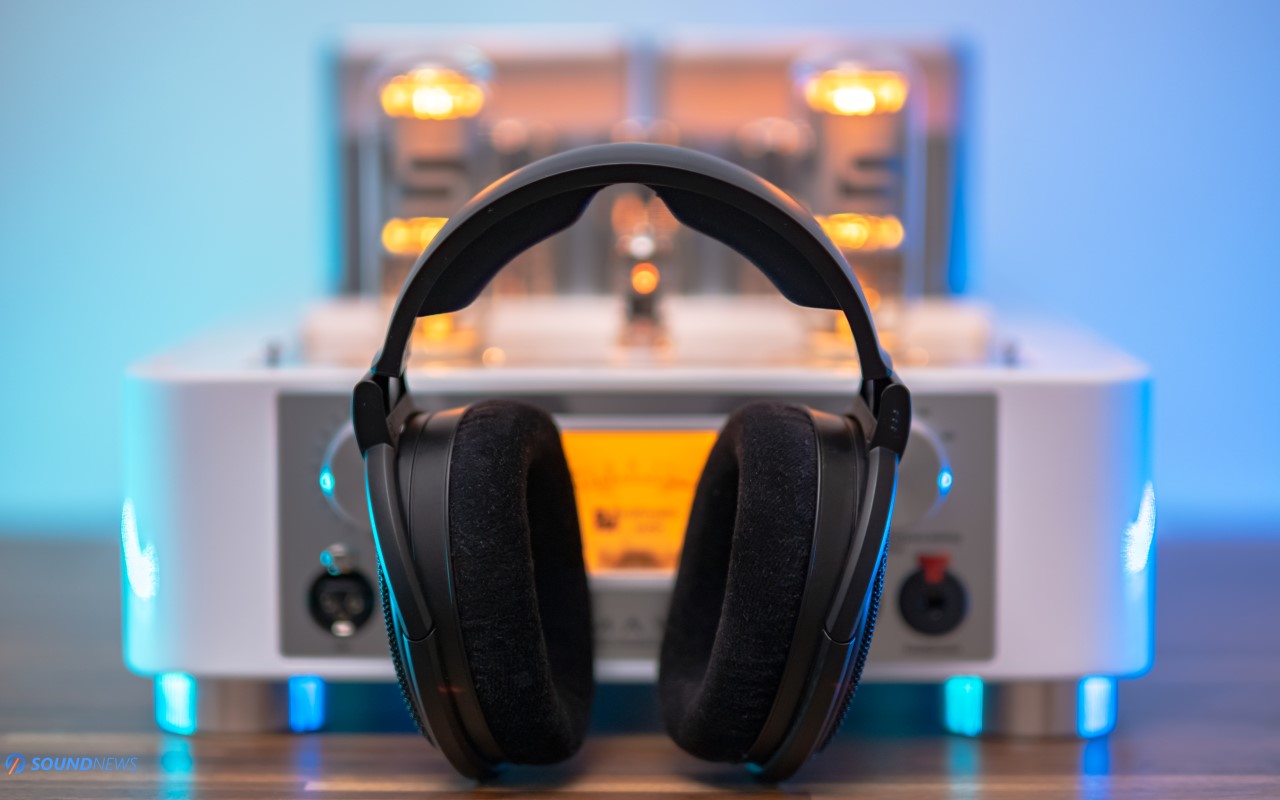
Sound Performance
I. Preliminary Impressions
It feels like Sennheiser invested precious time into making a brighter future for (probably) the best-selling audiophile-worthy desktop headphone lineup and before you ask: hey man, but did you burn them in for a couple of days? Of course, I did as these are by my side since the beginning of January. I put them on a wide variety of headphone amplifiers, so I could have a better feeling about their scalability, ranging from solid-state to full-tube amplifiers, from entry, mid-level, and state-of-the-art units, HD660S2 went through everything so I could better understand their performance and more importantly, their limits. I didn’t put 500 hours on these, that would be counterintuitive to my line of work, but around ~150 hours they surely have under their belts, or should I say under their earpads.
If you ever experienced the notorious Sennheiser house sound and more exactly the HD6XX line of headphones, then you already know that the HD600 can be described as the most neutral sounding one, a warmer and thicker sounding HD650 came next and to everyone’s surprise, HD660S2 feels like a denser, creamier and bassier version of HD650, while adding more transparency, better control of the drivers, faster decay and you guessed it – a much better bang in the bass region that everyone begged for.
Measurements and subjective impressions aside, HD650 were bloody impressive sounding in the midrange department and everybody loved them for that, leaving a nicer treble performance for their flagship HD8XX lineup and bass-heads in the dust, as sadly there weren’t open-back Sennheiser headphones that could do rock, electronica and all sorts of modern tunes proper justice.
The waiting is finally over, as clearly HD660S2 aren’t only bassier, deeper, and punchier sounding than any other cans from the HD6XX lineup, but compared to any other open-back Sennheiser headphones. Their closed-back HD820 could deliver powerful blows with the right selection of music and electronics, but those came with additional issues that nobody wanted to deal with. According to my MiniDSP E.A.R.S. and also to Sennheiser readings, the whole sub-bass region went up by about 5 to 6 dB, which completely changed my feelings about their newest creation. Just think about it, a 6 dB increase is roughly doubling the sound pressure level and you can feel that immediately, even with relaxing tunes. The bass is more playful, it is deeper reaching and finally, there are additional layers that make me believe I’m getting a clearer and more defined version of it. There isn’t only more bass quantity-wise, it’s more controlled without breaking up when the music goes wild. There is less distortion in there, as the drivers aren’t working that hard, leading to a higher-quality bass as well.
I still remember when I got my first set of Audeze LCD-2 OG back in 2009 and the very first thing that impressed me was their juicy, layered, and deep-reaching bass that my HD650 lacked at the time. Slowly but surely, I moved my attention to planar headphones as those were doing a few things better, plus their wall-of-sound felt so intoxicating with live and rock tunes, I couldn’t get enough of that. However, if something like HD660S2 would sit on my table, I’m not sure if I would be upgrading so easily. In the end, we are still talking about the Sennheiser HD6XX sound, which felt complete from top to bottom. I’m no longer impressed only by the midrange, as I feel more energy dwelling below and the treble feels more textured as well. From a somewhat rounded HD650, Sennheiser went ahead and expanded the frequency response, planting more life at their extremes, more exactly below 40 Hz and above 12KHz, two specific areas where HD650 didn’t shine that bright.

II. Power Requirements & Amp Pairings
Just like that, Sennheiser decided that the 300 Ohm voice coil of older models is better than that of HD660S. They shortened the voice coil as well and you can see that with your own eyes while closely inspecting both units. The magnetic force that puts the voice coil into motion is no longer losing a lot of traction…but since their impedance doubled, HD660S2 are less sensitive by about 2 dB versus their predecessors.
With all that being said, we are still dealing with a Sennheiser dynamic headphone, meaning that these won’t require nuclear reactors to be moved and enjoyed to their maximum potential. The included 4.4mm balanced cable which is shorter this time around (1.8m) came in handy as just before bedtime, I used them with all sorts of portable devices ranging from USB dongles, Bluetooth gizmos, portable amplifiers, DAC/Amp combos, and stationary all-in-one units that had beefier headphone amplifier sections. I wasn’t surprised getting decent dynamics from battery-operated devices, but bigger ones like Shanling H7 and FiiO Q7 sounded a whole lot better. When going from smaller devices like FiiO BTR7 to bigger devices like FiiO Q7, the biggest gains weren’t only dynamics and better driver control, but also detail retrieval and transparency, scaling nicely with clean-sounding gear.
While not exactly power-hungry, these felt explosive at times with desktop gear, especially when put on massive headphone amplifiers. I still don’t recommend using ginormous units, that wouldn’t be necessary, as a mid-fi desktop setup would be more than enough to make them sing. If you love transparency and detail retrieval, nothing would do it better than a Topping A90D, SMSL HO200, or any other THX-AAA amplifier. If you need a perfect balance between musicality and technicalities, then a fully-discrete solid-state amplifier would be my weapon of choice. Check Flux Lab Acoustics and Burson Audio creations and if your budget is quite limited, then take a look at that Singxer SA-1. If you need a nicer depth and soundstage while pouring milk and honey over your tunes, check output-transformer-less (OTL) tube amplifiers and if you need the sweetness of OTL with the speed, dynamics, and power of fully-discrete SS amps, then look no further to end-game transformer-coupled tube amplifiers from the likes of Feliks Audio, Cayin or Trafomatic Audio.
I won’t kid anybody by mentioning that HD660S2 sounded best out of a Trafomatic Primavera ($15.000), but I still enjoyed them from an SMSL HO200 ($400). Set your mood straight and you’ll be just fine.

III. Transient Response & Dynamics
The princess of the deepest pits of Tartarus finally visited us, please welcome her majesty Bass, everyone has been expecting you. There is indeed more bass, measurements, and subjectivity-wise everything went up and you can feel that with all kinds of tunes, not only with bass-intensive music. With regular tunes, there is a louder thump, more oomph, and fullness as if listening to three-way stand floor loudspeakers versus two-way bookshelves that throw no punches below the belt.
HD660S2 are scarier, meaner, and more impactful and this is what I like about them. You can make them scarier if you want, but for that, you’ll need third-party leather earpads, check DekoniAudio for a few options. In their stock form, there is plenty of life to impress an electronic music addict, as the speed and decay of the notes improved as well. There is less wobble in front and behind the drivers, better decoupling them from the earcups, improving their timing in the process. The sound is no longer diffused, blurred, or veiled as people used to say, it’s tighter and faster this time around, ultimately improving the speed of sound. These are no longer cruising at 50 Km per hour on the highway and that’s a good thing as I never liked the slow nature of HD6XX drivers.
With all that being said, please don’t expect the thunder god paying a visit, as I’m still describing an open-back dynamic headphone. These are faster and more impactful, but they won’t outperform pricier planar-magnetic headphones that could do that a little better. At $599 these are slightly more expensive to my expectancy level, but they will stand their ground versus close competitors, be them dynamic or planar-magnetic ones.
You can make them faster with all-discrete solid-state electronics and you can make them punchier with hybrid or full-tube amplifiers. These smashed and pounded on a Trafomatic Primavera and Enleum AMP-23R, losing some magic with smaller and more affordable units. I want to be clear that with stock velour earpads there’s enough sub-bass extension and mid-bass definition, but the sound won’t scare you off as it might happen with planars put on big-boy amps. These won’t make your head move and your feet dance around the house, but there is still plenty of energy left, especially when dynamics are reaching their upper limits.

IV. Soundstage & Depth
These are still part of the good old Sennheiser HD6XX family, getting a closer-to-your-face type of sound, going with a mid-forward tuning that won’t stretch that wide, offering little depth along the way. Their sound staging capabilities are good enough, but these won’t pose a problem to something like a Meze 109 PRO or Hifiman Edition XS. You aren’t buying a set of HD660S2 for out-of-head experiences, but for their tonality which aged so well, like a single-malt whiskey forgotten in an oak barrel for at least a decade. I will cut it to the chase and mention that even several cheaper alternatives will sound bigger, deeper, and wider on all axes. From the house of Sennheiser, even HD560S will do that and after going a little higher, I feel that Moondrop Venus and Hifiman Edition XS will be putting more music all around you, at higher altitudes and distances from your face.
This is where HD660S2 were just okay and there’s nothing bad about it. Sure enough, these sounded bigger on R-2R ladder DACs and even bigger put on OTL and transformer-coupled tube amplifiers, but the change wasn’t massive by any stretch of my imagination.
However, there is one thing that felt improved and after going back and forth between old and new models, you will realize that the newer model has a clearer stereo image. Usually, the HD6XX line is quite fuzzy and diluted, the notes aren’t sharp enough, having less impressive leading edges. The newest model felt sharper and tighter sounding, having less wobble and distortion that led to a clearer picture projected before my retina. These won’t outperform the sharp contours of HD800 & HD800S…but these are gently trying to mimic that stereo image, becoming desirable versus their siblings.
50 years ago on March 1st, Pink Floyd released their iconic Dark Side Of The Moon to widespread acclaim as one of the most commercially successful rock albums of all time, building on ideas previously explored in earlier works, while omitting the extended instrumentals that previously characterized the band. Following whispers and rumors abounding, the official announcement has been made, as 50 years later we will get a re-release of The Dark Side Of The Moon this year. They already released a single track that you can audition via Qobuz or Tidal, although Qobuz offers a better-sounding version (lossless 24-bit/192 kHz) which sounded sublime on HD660S put on tubes. Brain Damage sounded clearer versus the 2003 and 2011 remasters, which in turn felt grain free and clearer than the original 1973 release. This album doesn’t need an introduction, but it does sound a little crisper versus its previous iterations. It’s more polished, sounding great as it should, getting a livelier and punchier sound, whilst providing a relaxed & comfortable music delivery. There’s none of the edginess of 21st-century remasters and I’m really curious about the final release, which I will be getting on CD as a self-present. It wasn’t a challenge spotting a clearer and livelier performance via HD660S2, as honestly, these are more than capable of showing additional details brought to the surface.

V. Detail Retrieval & Transparency
An old folk tale still makes rounds across online forums, speaking about the famous Sennheiser veil that people whispered in dark corners at headphone meetings. That was indeed a thing on earlier HD650 units, but a few years later these were redesigned for a crisper sound all around. With all that being said, more affordable cans like HD600 and HD560S sounded equally impressive, maybe even clearer and defined in the treble department. For better linearity and detail retrieval, HD600 was recommended left and right and for a warmer and sweeter tonality, HD650 would reign supreme. When Sennheiser released HD660S, it felt like a side step tonality-wise, but as an improvement in terms of transparency and overall cleanness and it seems that HD660S2 yet again pushed those drivers closer to their limits. I’m faintly hearing additional information, especially at frequency extremes. There are additional layers of bass, improving bass quality more than anything, plus there’s more zing and bite in the treble, without making them fatiguing long term.
It feels like the newest release sits exactly in between HD650 and HD800/HD800S, removing the veil as if it never existed. I did my good share of measurements, which I will be showing shortly, but as I was listening to more music it felt that the treble is similar yet different at the same time. There aren’t peaks in the most sensitive part of our hearing (as HD660S had) and finally, there’s a little more information appearing past 12kHz. The funny part is that HD660S2 are fuller-bodied, yet more extended sounding in the treble, which feels like an unexplained phenomenon to me.
In the second chapter of this review, I was explaining about the differences between small USB dongles, portable DAC/AMPs, and desktop components. While dynamics were quite different going up and down depending on headroom remaining on tap, higher-quality equipment had something else to say and that was transparency and detail retrieval. There was quite a difference in between a Shanling UA5 and FiiO Q7 for example, the latter getting substantially clearer sounding. All these major differences wouldn’t be as clear if I wouldn’t have resolving headphones in my hands and that’s exactly how I would describe their sound: A more resolving version of the HD6XX house sound, that almost touched the legendary detail retrieval of HD800.
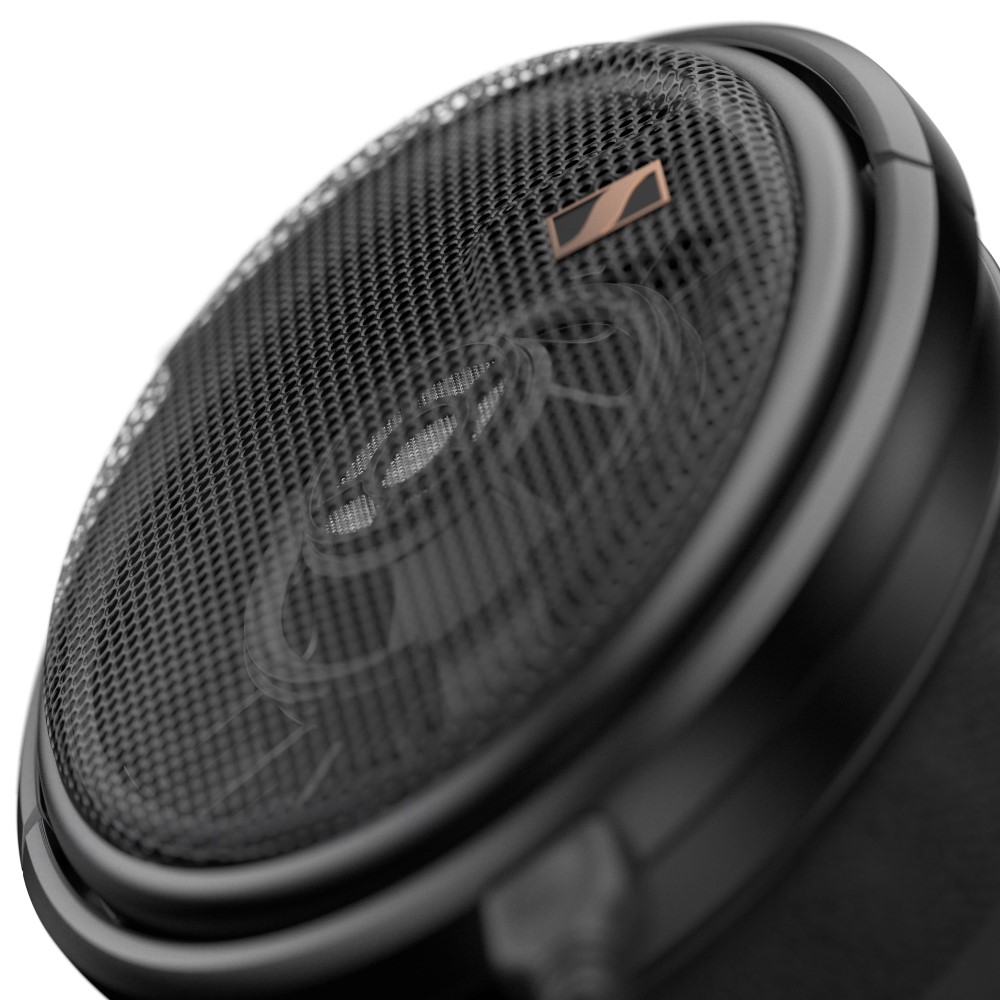
Frequency Response
VI. Bass
Combining everything Sennheiser wanted to achieve into a single idea, then we are arriving at their bass performance, which sincerely is the biggest improvement. You no longer need to mod anything, you don’t need fancy cables and overkill amplifiers, as finally the whole bass region was revitalized, infusing a higher fun factor. The whole region went up and that’s plain as a pikestaff. The sub-bass region saw the biggest improvement, going up by ~6 dB to that found on the original HD660S. The first model lacked energy and the newest one feels closer to a linearity curve, providing more information along the way. Nonetheless, don’t look at them as bass-heavy headphones as that isn’t going to happen. The 20 Hz region is still not reaching a linearity curve, but you’ll hear a much nicer sub-bass definition and a higher sound pressure level. You will easier feel the lowest octaves of a piano note (~27 Hz), the kick of the bass drum (~50 Hz), the lowest vibration of a bass guitar (~41 Hz), or of a double bass (~55 Hz) on the newer model without too much trouble. With all that being said, these aren’t drawing your full attention towards the low-end, but mostly to their mid-bass region which was richer and more playful. The mid-bass that the HD6XX lineup is known for is still lingering inside their cups and you can make it even stronger with fully-discrete Class-A amplifiers or with a mild EQ curve. In the end, it seems that Sennheiser engineers wanted to steal our attention with a higher-quality bass this time around, as every double-bass strokes and snare drum hits felt livelier than before.

VII. Midrange
The region that conquered our hearts a long time ago is undoubtedly the midrange which feels exactly as vivid and colorful as it was ever before. If you tried an HD650 before, then these are pretty much the same, with added crispness, detail, and control. I just finished listening to a three-album marathon, covering most acoustic genres and I was so close to adding a fourth album to the playlist, precisely because everything felt yummy, sweet, and velvety sounding. Antimatter’s Profusion Of Thought (Qobuz / Tidal), Eloy’s Power And The Passion (Qobuz / Tidal), and Reinaldo Brahn’s Brasileiro Soul (Qobuz / Tidal) went in a flash, The time flew faster than a flying saucer as I couldn’t do anything else other than nodding my head and tapping my feet. HD660S2 aren’t flawless sounding by any means, but I can certainly call them this way when describing their midrange performance. There was a sense of intimacy and comfort, which made the midrange close and personal. I’m not bothered by a forward midrange which I’m getting served over and over again, it’s my favorite frequency region, but it can get a little claustrophobic, especially with cozy jazz tunes. Besides being clearer sounding, these are also richer and warmer sounding, more so than any of their siblings. Depending on your setup and musical preference, this could be a major attraction or a minor drawback, but I still get that signature Sennheiser midrange that people are enjoying for a long time now.

VIII. Treble
On one hand, there’s less energy in the most sensitive part of our hearing versus their predecessor, on the other hand, there is slightly more energy above 12 KHz. In simpler words, the newest model is more extended in the treble this time around, without trying to bother you with bright trebles or listening fatigue. Their predecessor had a single peak at 8kHz, but that’s no longer happening, getting a smoother and gentler treble delivery. If it feels that I’m describing the warmest and sweetest-sounding headphones from the HD6XX lineup…then that’s the truth. Their tone is more relaxed than a serious HD660S and HD600, providing an inviting and smooth listening experience. I tried making them bright and I tried it hard, but none of those THX-AAA amplifiers or ESS-Sabre-based oversampling D/A converters could make them razor sharp or bothering in long listening sessions. This kind of treble is to my liking, as I can listen even to some aggressive stuff without powering on a tube amplifier, try doing that with a Hifiman Sundara or Beyerdynamic DT1990, it won’t going to happen.

IX. Sennheiser HD660S2 Detailed Measurements
Alright everybody, let’s check some measurements. My main DAC for the job was a Chord Electronics DAVE fed via BNC from a Singxer SU-6 that isolated the USB signal coming from my PC. I didn’t follow it with a headphone amplifier as DAVE can easily drive them to ear-bleeding levels. The measurement rig used was a MiniDSP E.A.R.S. calibrated with HPN (Original Headphone Compensation) files. Do note that E.A.R.S. is not following any known IEC standards and my readings can’t be used as reference measurements or anything like that. I’m doing them for fun, getting a general idea about their sound signature.

I measured them several times in a sealed room, as I needed to match both readings as close as possible. No side pressure was applied to their earcups, they stood still in their natural position. Take a look at their RAW measurements without any smoothing applied. Driver matching is outstanding, it looks better than the last desktop headphones I measured as of late. There are indeed some minor deviations in the treble, but those are negligible and you can’t hear them in real-life listening tests.

After applying a gentle 1/12 smoothing, I got a slightly different graph and as you can see, they offer a straight line from 50 Hz to around 1 kHz, suggesting an exemplary bass and midrange performance. You can see a tiny roll-off happening in the sub-bass and another slope in the upper midrange, but that’s normal behavior, as most open-back headphones are doing the same and by a lot better compared to that of HD660S. The most sensitive part of our hearing (in between 4 and 7 kHz) is looking great and it’s actually 1 dB lower to the 300 Hz SineWave.
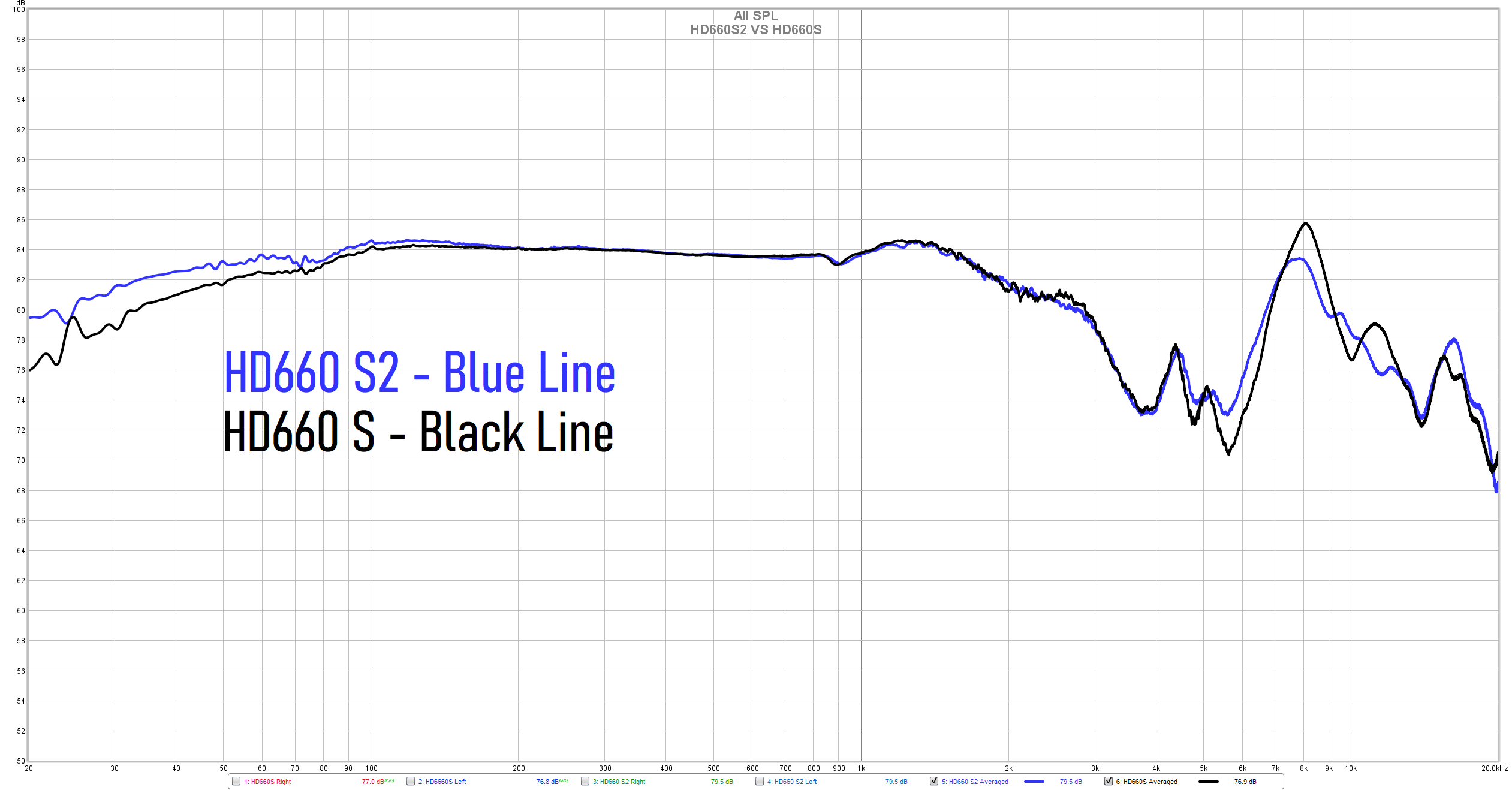
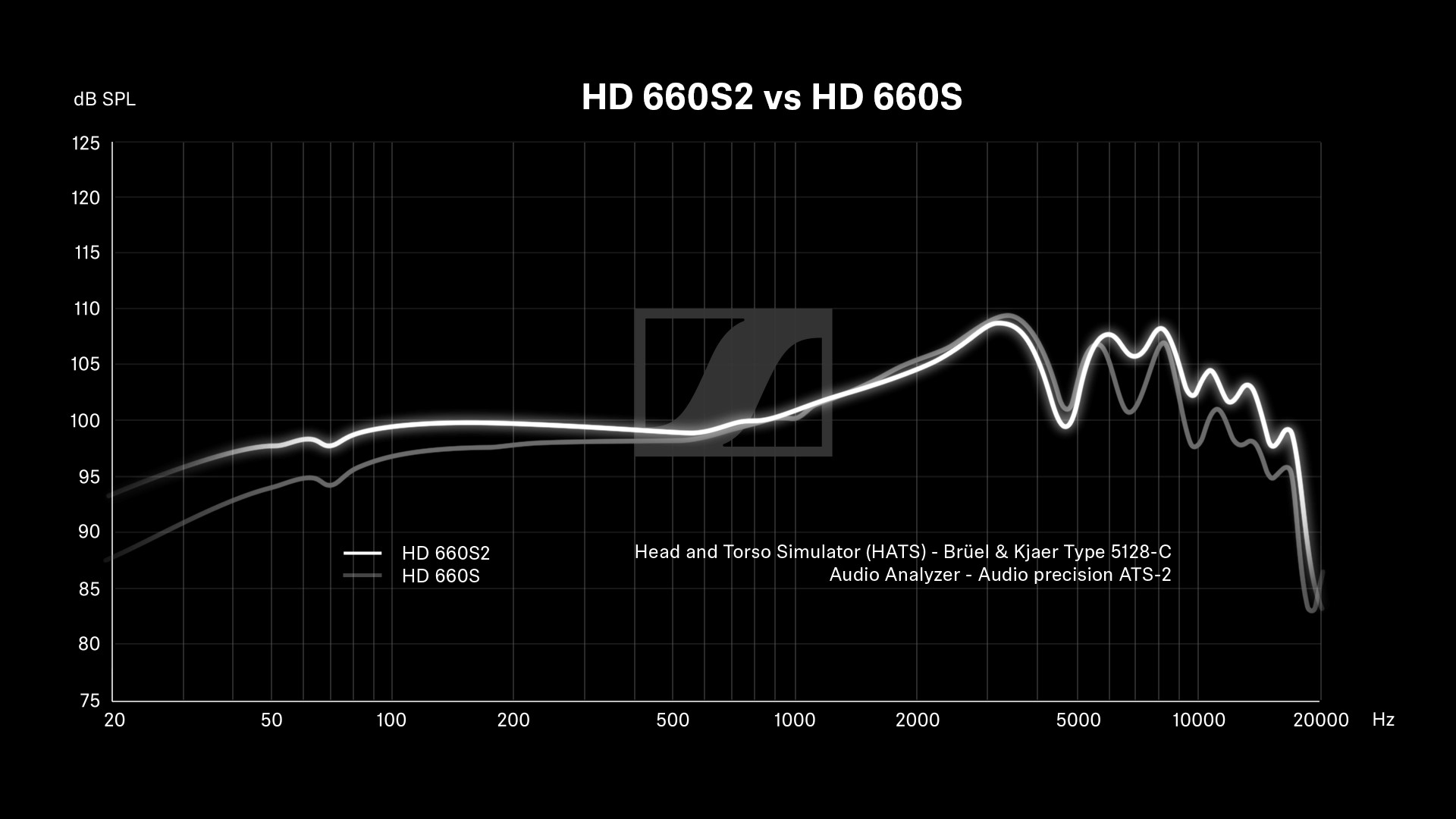
If you are curious how the newest model stacks against the old one, here is my reading and another one provided by Sennheiser. To nobody’s surprise, the newest model covers a wider frequency response at both ends, you can see the biggest difference happening in the sub-bass and a smaller one in the upper treble.

Their THD reading is decent, it’s certainly better than that of HD660S, but these are still distorting a little in the sub-bass region. At 84dB, THD went up to 5% in the sub-bass, but everywhere else it remained cool, sitting in between 0.1 and 0.2%.

Spectral decay looks good, but it’s not exactly outstanding. After sending a 300 Hz sine wave at 84 dB, it drops to 15 dB at the lowest point and to 67 dB at the highest point after 160ms, usually staying in the neighborhood of 33 dB, which is decent by my standards. A faster decay can be usually obtained from planar-magnetic drivers, so we are still good.

Waterfall combines the FR plot and decay into a single graph and you can see their FR from another angle including their impulse response, coming closer to linearity compared to their past doings.

The spectrogram shows a minor ringing happening between 20 and 30 Hz and another one between 50 Hz and 60 Hz, but there aren’t nasty vibrations building up anywhere else. I cannot hear that ringing myself and you shouldn’t worry about this too much.
Overall, I have recorded a wider frequency response versus their predecessor, a lower distortion, and slightly faster decay.
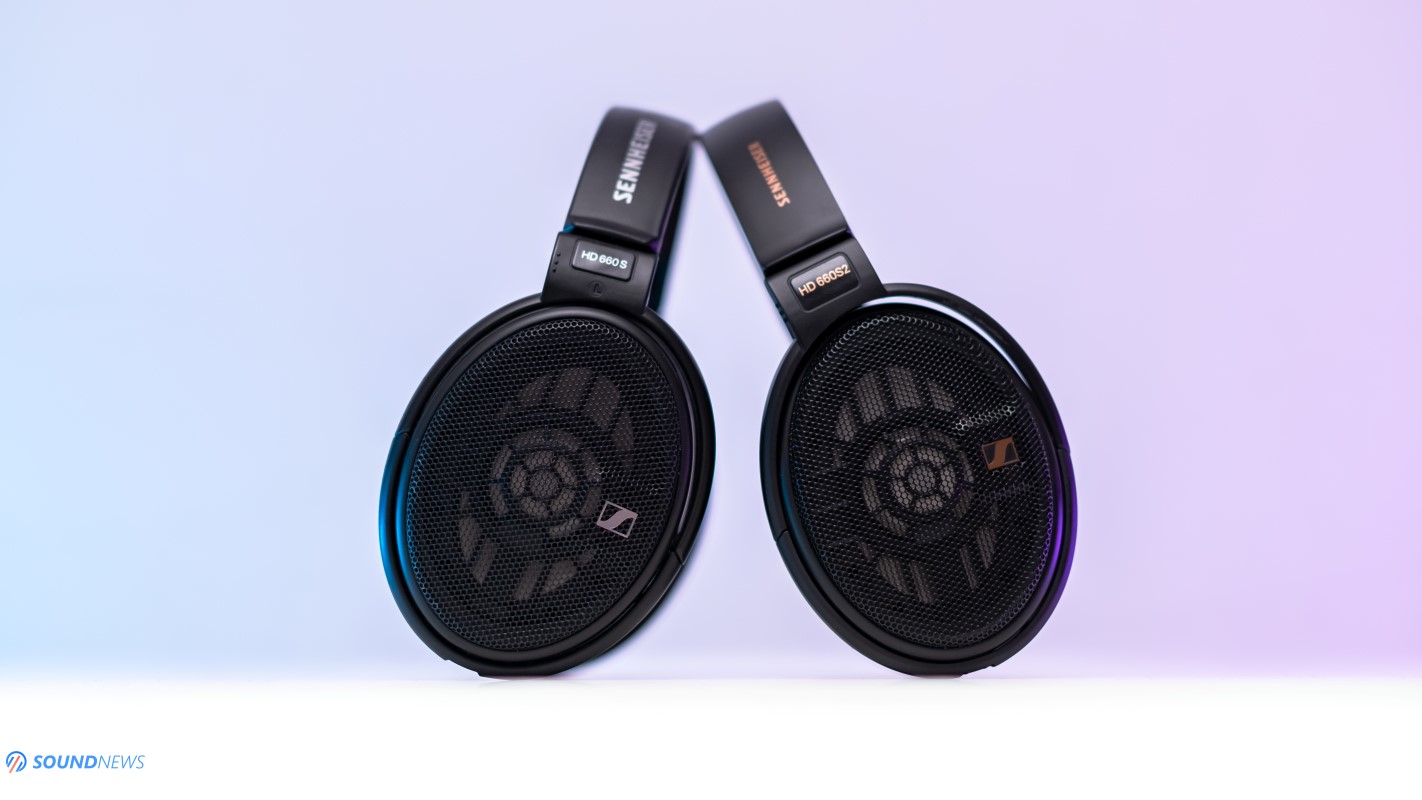
X. An Important Comparison
Sennheiser HD 660S2 ($599) VS Sennheiser HD 660S ($499)
I will skip their build quality, specs, bundled accessories, and packaging, focusing my attention only on their performance. I used fresh earpads on both models, the same balanced cables, and the same desktop setup consisting of a Chord DAVE and Trafomatic Primavera. Since the newer model is less sensitive and demands additional power for a similar SPL, I volume-matched them playing my tunes at 90 dB.
After swapping them back and forth the immediate change was felt in the frequency response, more exactly in the bass region. The newer model breathes new life into an already excellent performing headphone. What was passable in terms of dynamics and transient response felt further optimized, getting a deeper, clearer, and slightly faster bass performance. I can finally write about bass slam in an open-back dynamic headphone, something that I would never do with any of their open-back cans… except HD800S put on high-end tube amplifiers.
When HD660S was released a few years ago, some people embraced improved technicalities, but others didn’t like their sound tuning by putting them closer to HD600 rather than to HD650. The original HD660S felt too serious at times, always trying hard in impressing a music addict. HD660S2 no longer needs to do that, as I find them smoother sounding, livelier, and meatier sounding than HD650. This is quite probably the most organic-sounding headphone from their entire portfolio. The newest model knows how to make you feel great, it doesn’t try to steal your attention with immaculate technicalities, but more with the act of music listening, putting you into a relaxed state of mind.
Switching over to reference recordings, you can feel a better grip and control in the lowest octaves. There is less flabbiness at higher volumes and subsequently a lower distortion. There are fewer potholes along the way, and the road is no longer bumpy, getting more music and a stronger bond with it. Music breathes easier on the newest model and while both are more or less the same sound stage wise, stereo imagining is clearer and more precise on HD660S2. The smallest intricacies have a clearer body and stronger contours and I can easier zoom in on things happening behind less-than-perfect recordings.
Another observation would be effortlessness and the joy of listening to music which can’t be measured by anything, except for our brain. All these things combined make them right from the get-go. There isn’t an accommodation time anymore, you just put them on, and Boom! The next second you’re feeling the vibes without making additional tweaks.
The biggest issue that I see right now is the price. Making room for the newest model, Sennheiser lowered the price of the original model to $299 and while HD660S2 are indeed better sounding and better measuring, these still don’t perform two times better as their street price might suggest. The newest ones are undeniably better sounding, but are you willing to pay the extra cash for a moderate increase in performance? That’s a question that you need to ask yourselves. It is up to you to decide if the upgrade path is worth it or not.

My Conclusion
This hobby should be about having a blast, about the fun times & positive vibes and while Sennheiser slightly derailed the train with the HD660S release, they got back on track with a wackier-sounding HD660S2. Undoubtedly, these are a joy to listen to and while I no longer have the original HD580, HD600, and HD650 by my side, these feel like a natural follow-up, an extension to that kind of sound, getting even smoother, warmer, wider frequency wise and considerably more technical sounding along the way.
The build quality remained unchanged and that’s both an advantage and a drawback. I still have a few balanced cables around the house, including a pair of earpads that I can use with their newest cans, but it’s a drawback for those expecting fresh looks or a complete redesign. The good part is that the price didn’t skyrocket uncontrollably, sure…these are pricier than any of their HD6XX family members, but they should be as there are decades of fine polishing and fine-tuning until HD660S2 came to fruition. These deserve the full attention of Sennheiser fans and the curiosity of newcomers that are still asking what’s the fuss about the German house sound.
These won’t WOW you with ultimate comfort levels and rock-solid build quality, but these will certainly make you feel warmer inside with their intoxicating midrange performance. Finally, these are pounding harder in the bass and are shining brighter in the treble, strengthening their fanbase and winning our well-respected Silver Award.

The saga continues with HD660S2 and I’m looking forward to what’s coming next. Sennheiser’s HD660S2 will cost you $599 and you can get them from their International web store or from your nearest Sennheiser dealer. If you’re already a happy head-banger, then please leave a comment below and let me know how these are treating you.
PROS:
- Timeless design and build quality
- Less e-waste due to a smaller cardboard package
- Shorter 1.8-meter cables
- A natural evolution of the Sennheiser house sound
- An extended frequency response versus its predecessors
- A much better low-end delivery
- Better technical performance on all fronts
- Richer and fuller-bodied all around
- Clearer and more accurate sounding than ever before
- Offers a sharper stereo image
- There is less distortion at high SPL
- Nicer measurements all around
CONS:
- Not as efficient
- Their price went up
ASSOCIATED EQUIPMENT:
- DACs: Chord Electronics DAVE, Gustard R26 Discrete, Gold Note DS-10 PLUS & PSU-10 EVO, SMSL D400EX
- Streamer: Zidoo Alpha NEO
- Roon Core: Roon Nucleus
- DDCs: Denafrips Gaia, Singxer SU-6, Matrix X-SPDIF 3
- DAPs: FiiO M17, M11S, Shanling M7, M6 Ultra, Hiby RS6
- Headphone Amps: Trafomatic Primavera, Trafomatic Head 2, Ferrum OOR + HYPSOS, Enleum AMP-23R, Burson Soloist 3X GT, Flux Lab Acoustics Volot
- Preamps: Chord Ultima 3 Pre
- Power Amps: Chord Ultima 5, Burson Timekeeper 3X GT (x2)
- Loudspeakers: KEF Reference 3, Sound of Eden Crescendo UNO, Musician Knight 1
- IEMs: FiiO FH9, FH7S, Meze Rai Penta, LittleDot Cu KIS, 7Hz Timeless, Kinera Skuld & others
- Full-sized headphones: Sennheiser HD660S2, HD660S, HD800S, Meze 109 PRO, Meze Elite, Audeze LCD-5, Audeze LCD-4, Hifiman Susvara, Hifiman HE1000SE, Arya Stealth, Erzetich Phobos V2021, Erzetich Mania, Kennerton Rognir planar, Vali, Apos Caspian, Sendy Peacock, Apollo, HarmonicDyne Poseidon & others
- Interconnects: QED Reference (x2), Topping TCX1 (x2)
- USB Cables: Supra USB Excalibur (x2), Chord C-USB, Matrix Hi-Fi USB
- HDMI Cables: Supra 8K HDMI 2.1 (x2)
- Speaker cables: Kimber PR8, Audioquest Type4
- Power Cables: Isotek EVO3 Premier (x3), iFi Audio SupaNova (x2)
- Balanced Isolation Power Conditioners: PLiXiR Elite BAC1500 (stereo setup), Elite BAC400 (headphone setup)


